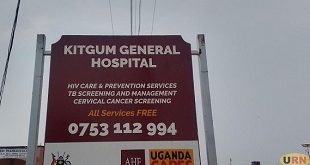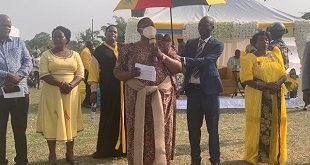
Stella Kabasinguzi is a mother of twins. She gave birth to the two boys by C-section at Kyenjojo Hospital in western Uganda. They arrived preterm weighing only 2kg and 1.7kg at birth and were in danger of dying if it had not been for the hospital’s neonatal intensive care unit incubator which enabled the hospital to give them necessary lifesaving care.
Kampala, Uganda | Agnes E Nantaba | A new report released by the American embassy in Kampala on June 14 highlights incidents like this to show the difference made in real lives of people by assistance given by the American government to Uganda’s health sector. One such programme caters for mothers facing a high risk pregnancy with twins and provided the incubators that saved Kabasinguzi’s twins.
“These are stories about the people of Uganda and their accomplishments driving the country’s progress,” said U.S. Ambassador Deborah Malac, “And America is proud to be a partner.”
The report titled ‘Report to the Ugandan people” shows that in 2016, the U.S. provided more than $840 million (Shs 2.9 trillion) in assistance to Uganda and more than half; $488.3 million (Shs 1.7 trillion), went to the health sector. The assistance makes Uganda one of the largest recipients of U.S. aid in the world.
Most of the U.S. assistance goes directly to the people, not through the Government of Uganda budget channels, and directly supports services that improve the health of mothers and children, and targets reduction of the threat of infectious diseases like HIV, tuberculosis, and malaria.
One of the programs that was funded by the U.S. government is the ‘Saving mothers and giving life’ initiative. This aims at reducing maternal and perinatal mortality in four districts of Kabarole, Kamwenge, Kyenjojo and Kibaale in western Uganda. The program has helped lower the maternal mortality rate in these districts by 44 percent and the perinatal mortality rate by 9 percent.
The U.S. assistance also enabled 8.1 million people in Uganda to be tested for HIV/AIDS in 2016 through the President’s Emergency Plan for AIDS Relief (PEPFAR) and 94% of those found to be HIV positive to be started on life-saving antiretroviral therapy through the same initiative. It also enabled more than 466,000 men to be circumcised for HIV prevention, 1.6 million pregnant women to be tested for HIV, and more than three million Ugandans to be protected against malaria through Indoor Residual Spraying.
In the past, a major contributor to Uganda’s high HIV rate has been the transmission of the virus from mothers to their children during pregnancy, labour, delivery or breastfeeding. Under initiatives funded by the U.S. Centres for Disease Control and Prevention (CDC) and the U.S. Agency for International Development (USAID) through PEPFAR, the incidence of mother to child transmission has significantly lowered. HIV infection rates among tested babies have dropped from 12 percent in 2010 to 3.9 percent in 2016.
The U.S. funding also enabled 93 percent of children to get immunised against bacterial infections like pneumonia and meningitis. But the funding also initiated a five year project to prevent and eradicate malaria in 43 districts under the U.S. President’s Malaria Initiative (PMI) under which $41.4 million was allocated.
Underfunded sector
The U.S. funding to Uganda’s health sector is a relief to an underfunded sector. In the financial year 2017/18, the Uganda government allocated Shs1.824 trillion (Approx. U.S$500 million) only which is just 8.3 percent of the total national budget. This is a marginal drop from the current financial year where the sector was allocated Shs1.827 billion or 8.9 percent of the total budget.
According to the National Health Accounts expenditure tracking, Uganda’s per capita health expenditure stands at an average of US$56,176. This indicates that the country has 40 percent out of pocket expenditure which is still high if compared to the World Health Organisation (WHO) recommended maximum level of household out of pocket spending on health of 15 percent.
Ambassador Malac has been vocal about limited funding to the health sector, notably in January when there were proposed cuts of between 30 to 35 percent in funding to the health sector.
“Government of Uganda needs to do more to increase both investment and accountability in Uganda’s health sector if the country is to become healthier and ultimately more prosperous,” she said. She only slowed down when the cuts were reduced noting, “I am glad that we were listened to and in the end the cuts are less because the health sector in any economy is a growth industry”.
She reiterated that in a country like Uganda where the population grows by at least one million people every year, it means extra health care which explains the need to increase invest every year.
She further explained that, “the health economy in Uganda is four times bigger than the health budget of the ministry and yet the government only accounts for 23.4 percent of the response for a healthy economy”.
Despite the U.S. assistance, a funding gap remains. Last fiscal year, for example, the USAID Mission provided about $17 million budget for family planning services, including provision of about 50 percent of the condoms in the country. However, a recent Uganda Demographics and Health Survey (UDHS) report indicates that there is still a significant gap in terms of the need for family planning.
Uncertainty over funding
The new administration in the U.S. under President Donald Trump that seeks to cut foreign aid worldwide, the American embassy is yet to confirm what support America will offer to Uganda’s health sector in the next fiscal year.
In his first budget, President Donald Trump called for a dramatic reordering of America’s priorities with less money on people overseas and more money on people at home.
Ambassador Malac told journalists that the embassy has forwarded budget proposals and is awaiting appropriate allocations and funding decisions from the Congress.
“It will still be weeks if not months for us to have an idea on where the budget levels will end up,” she said.
She, however, confirmed an increase in funding for PEPFAR with over $402million allocated for the coming year and Heather Smith; the acting PEPFAR Coordinator, unveiled plans to increase coverage from 10 districts to 13 to reach about 250,000 adolescent girls and young women.
****
 The Independent Uganda: You get the Truth we Pay the Price
The Independent Uganda: You get the Truth we Pay the Price


